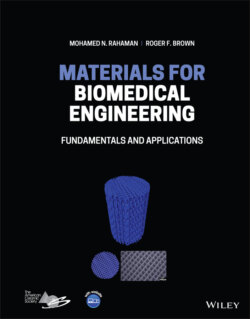Читать книгу Materials for Biomedical Engineering - Mohamed N. Rahaman - Страница 135
4.2.8 Hardness
ОглавлениеHardness provides a measure of the resistance of a material to penetration by a sharp object. Loading a material with a sharp indenter results in the creation of a permanent irreversible impression that is indicative of plastic deformation (Figure 4.12). This occurs even for brittle materials such as ceramics because the stresses due to a sharp indenter are sufficiently high to cause local plastic deformation. The hardness H is determined from the equation
(4.29)
where, F is the applied load (force) and A is the area of the residual deformation. While indenters of various geometry are available, the Vickers indenter consisting of a square‐shaped pyramid usually made of diamond is often used. The area A used in Eq. (4.29) is the actual area of the residual indent, that is, the area between the four faces of the pyramid and the surface of the solid after the indenter has been removed. Thus, for the Vickers indenter
(4.30)
where, 2a is the length of the diagonal of the indenter (Figure 4.12). The hardness determined from Eq. (4.30) is called the Vickers hardness. In another measure of hardness, sometimes called the true hardness, the projected area of indent is used in Eq. (4.29), giving
(4.31)
Figure 4.12 Geometry of hardness test using a Vickers indenter consisting of a square‐shaped pyramid. (a) Side view of the indentation test. (b) View of the indent looking directly at the surface of the material.
The true hardness is ~8% higher than the Vickers hardness and, thus, it is useful to state which hardness is being reported.
For some ductile metals, H is related to the yield strength σy by the equation
(4.32)
but a correction factor is needed for other metals that become stronger with increasing plastic deformation (a process called work hardening or strain hardening). As seen from Eq. (4.32), measuring the hardness provides a simple and nondestructive test for determining the yield strength of a material. There is no need to make tensile specimens and the indenter is so small that several measurements can be performed on the same material sample without severely damaging it.
Hardness controls the resistance to abrasive wear between the articulating surfaces of two materials. The harder the material, the less prone it is to wear. Wear is particularly important, for example, in implants used for total joint replacement (Chapter 23). The production of excessive wear particles between the articulating surfaces in these implants, such as between the CoCr ball and ultrahigh molecular weight polyethylene (UHMWPE) liner in a hip implant, leads to a severe foreign body response that invariably causes implant failure (Chapter 18).
